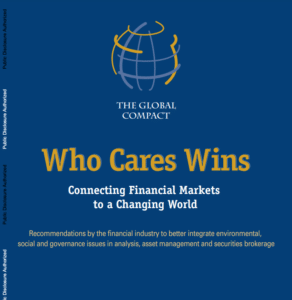Stormwater and ESG Investing Trends
On February 17th, 2022, a company called Actual seemingly started to crack an ESG investing trend most companies were struggling with: how to collect and visualize data when it comes to showcasing sustainable practices. Actual (created by LinkedIn alumni and based in San Francisco) raised $5 million, a signal for how demand on ESG accountability is growing.
When it comes to ESG investing, the trends since 2020 have steadily grown. In 2020 alone, ESG investing rose by 4%. With more companies starting to navigate towards capturing more long-term stable investors, ESG has become a significant buzzword.
Yet, companies continue to overlook how stormwater can be a significant component of their ESG principles. If ESG is the new normal, why aren’t more companies adopting stormwater management best practices?
What is ESG Investing
The basics: ESG stands for Environmental, Sustainable, Governance. With ESG investing, people invest in companies based on their adherence or mission towards environmental, sustainable, and governance best practices. Governance is often the outlier of this group that most misunderstand. Governance would include companies with a history of fair and equitable work practices, board management, and salary distribution. Examples of the top ESG investments according to Forbes:
- Vanguard FTSE Social Index Fund (VFTAX)
- Parnassus Core Equity Investor (PRBLX)
- Shelton Green Alpha Fund (NEXTX)
(Note that these are mutual funds with large tech companies in their portfolio, which some might find problematic. Another article for another time.)
The term ESG started in 2005 at a United Nations conference concisely titled “Who Cares Wins” (WCW). Both terms, ESG and WCW, were used to prove to financial institutions that companies proving that they care would win long-term investors and had the edge over companies who were not following transparency, environmental, and equity practices.
The conference conferred with global analysts, consultants, governments (the UN has pull), economists, and asset management companies. Their bottom line: ESG is a driving force for long-term investors.
Essentially, if you want a sustained investment, you better be focusing on environmental sustainability.
ESG vs. SRI
SRI (Socially Responsible Investing) was already in the financial narrative during the Vietnam era. Socially responsible investing focuses on not investing in something because of ethical or moral reasons. For example, people stopped investing in Phillip Morris because of tobacco’s ethical implications. SRI was about not investing in dubious companies, whereas ESG focuses on investing in companies for enhanced bottom lines and sustainable and transparent practices.
Where SRIs failed is how they limited investment opportunities. The mere implication that you avoid companies based on social responsibility didn’t encourage or champion investment opportunities for hungry yet conscious investors. At the same time, ESG investment blends conscious investment with strategic financial growth.
The Narrative of ESG Investing
Narrative Economists-economists focusing on how historical and cultural events have impacted economic forces-have had a busy few decades. The Who Cares Wins conference was only the beginning. Little did these experts know that a financial crisis was looming (2008), “woke” culture would be coined eight years later, and fifteen years later, there would be a global pandemic.
If the core of economics is that customer desire determines value, imagine how desires shift throughout crises. During a crisis, accountability is the demand. Think back to the BP oil spill (Deepwater Horizon, to be more specific), BP received overwhelming press and attention that the company had to take down BP signs and rebrand while still struggling to regain public trust. The resurgence of ESG as a high-traffic term can easily be traced to accountability from Covid-19 and the aftershocks of a shifting workforce. Plus, nothing triggers cultural dynamics quite like a global health pandemic where liberties and social responsibility are suddenly scrutinized at a high level.
Narrative economists predicted a surge in ESG investing at the beginning of Covid-19. On top of this, with a new incoming federal administration focused on rejoining Paris climate accords, equity, and infrastructure, it made sense to guess that investor eyes would move towards companies involved in these areas of ESG.
In 2020, ESG investments captured $ 51.1 billion of net new money from investors. For comparison, in 2019, investors accounted for $21 billion into funds that apply environmental, social, and governance principles.
ESG Scores
Spoiler alert, ESG scoring hardly exists. 1 in 5 investors didn’t invest
due to inadequate ESG policies. (This triggers many grumblings from portfolio managers who continuously point to a lack of transparency and visual representations to show accurate ESG data. Remember the company Actual, and this is why people are excited about the new wave of ESG visible data companies.) Until a tech is adopted, most companies rely on PR initiatives and reports to reflect their ideals.
Stormwater and ESG Investing: A Missed Connection
If you have made it this far down in the article, you are about to realize how deep we buried the lead. While companies tighten up their environmental impact, they tend to overlook an effortless staple in sustainability, stormwater management.
Stormwater management is an act of environmental justice as it aims to mitigate water runoff, damage, and pollution out of historically traumatized and disadvantaged low-income areas. Stormwater management is based on environmental justice and sustainable best practices, focusing on using green infrastructure to manage water quality. It also focuses on economic impact for neighborhoods that depend on actuaries, rivers, lakes, and oceans to fund their schools, businesses, and social services.
ESG Scores and Water Quality
As stated above, a current barrier is the lack of data and visual proof for ESG scoring. How can an institution prove its commitment outside of PR and annual reports? Here’s where another advantage of stormwater management comes into play. Companies can easily demonstrate their commitment to water justice since stormwater management includes visible green infrastructure*. Examples of this would be companies who control and manage their water runoff through new parking lots using bioswales to filter pollutants before they hit storm drains. Or rain gardens and landscaping to mitigate runoff. Companies such as Wholefoods in Raleigh, North Carolina, use giant cistern systems to manage runoff and recycle water have a built-in (pun intended) advantage of visual impact. Let’s not forget the documentation of water retention credits as proof too.
The Stormwater Solution
For the month of March, Rainplan’s focus is driven heavily on acquainting property owners with the financial literacy that comes with upgrading to stormwater technologies. The economic benefits of saving on stormwater utility fees, Stormwater Retention Credits, water bills are initially the first benefits listed. Yet, from a company standpoint and in regards to the growing ESG investment trends, using stormwater management as an indicator of environmental and sustainable practice should also be a highlight. With considerable investment from federal infrastructure acts, continuous severe weather, decade-long droughts, and societal accountability–stormwater management makes the most sense.
—-
* #notallgreeninfrastructure. Understand that some stormwater management technologies (dry wells, for example) are not visible nor photogenic. Fortunately, we have a Rainplan you can use as supplemental materials to show water quality commitment. Create one HERE.





